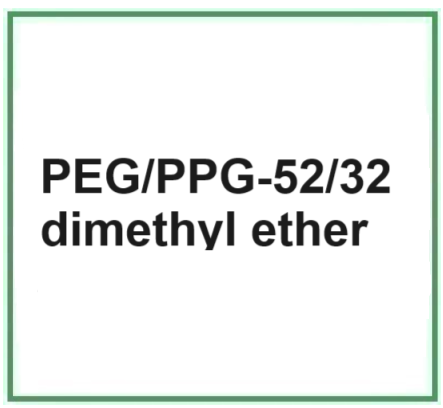PEG/PPG-52/32 dimethyl ether is a chemical compound, the copolymer obtained by 52 mol of ethylene oxide with 32 mol of propylene oxide.
The name describes the structure of the molecule
- PEG/PPG indicates the presence of a mixture of polyethylene glycols (PEG) and polypropylene glycols (PPG).
- 52/32 represents the ratio between the number of ethylene oxide (EO) and propylene oxide (PO) units in the mixture.
Raw materials used in production
Mixture of Polyethylene Glycols (PEG) and Polypropylene Glycols (PPG) - This is the main component of the molecule. Mixtures of PEG and PPG are used as solvents, emollients, and moisturizing agents in cosmetics and the pharmaceutical industry. The ratio of PEG to PPG (52/32 in this case) indicates the proportion of the two polymers in the mixture.
Dimethyl Ether - It is an organic solvent that contributes to the solvent properties and viscosity of the mixture.
Step-by-step summary of industrial chemical synthesis process
- Material Preparation - It starts with the preparation of the PEG and PPG mixture, as well as dimethyl ether and other necessary reagents.
- Measurement of PEG/PPG Ratio - The desired ratio of PEG to PPG in the mixture is determined.
- Mixing - The components are mixed together to achieve the desired mixture.
- Addition of Dimethyl Ether - Dimethyl ether is added to the mixture to achieve the desired viscosity and solvent properties.
- Purification - The resulting mixture is purified to remove any impurities or residual reagents
Form - PEG/PPG-52/32 dimethyl ether is often marketed as a clear, viscous liquid.
Color - It is colorless or may have a slight yellowish tint depending on impurities present in the raw material.

What it is used for and where
Cosmetics
Skin conditioning agent - Miscellaneous. This ingredient has the task of modifying the condition of the skin when it is damaged or dry by reducing its flakiness and restoring its elasticity.
Since the PEG (Polyethylene glycol) family is very numerous and can be found in cosmetic, industrial, pharmaceutical, medical and other products, we need to make an introductory statement on the subject, which is rather complex from a safety point of view because these products not only come into contact with the skin, but, as in the case of medical products, are ingested.
PEGs (polyethylene glycol) polymerise condensed ethylene oxide and water and are referred to as polyethylene glycols, but are actually complex chemical components, polymers bonded together. For example, plastic is polyethylene and has a hard consistency, while polyethylene combined with glycol forms a liquid. PEGylation is produced not only as etherification, but also as transesterification, which is the transformation of an alcohol by an ester.
The number appearing after the abbreviation PEG represents the molecular weight and the higher this number is, the less it penetrates the skin.
Safety.
The term 'eth' refers to the ethoxylation reaction with ethylene oxide after which residues of ethylene oxide and 1,4-dioxane, chemical compounds considered carcinogenic, may remain. The degree of safety therefore depends on the degree of purity of the compound obtained. At present, no manufacturer is known to provide this information on the label.
![]() PEG (Polyethylene glycol)/PPG-52/32 dimethyl ether
PEG (Polyethylene glycol)/PPG-52/32 dimethyl ether 


